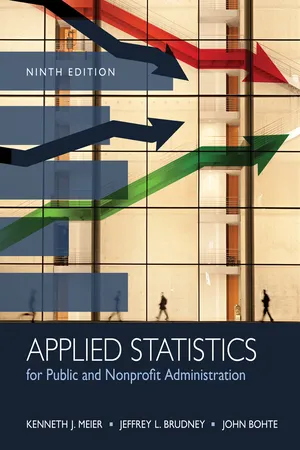Mathematics
Frequency Polygons
Frequency polygons are graphical representations of frequency distributions. They are created by plotting points at the midpoints of the intervals and then connecting these points with straight lines. The resulting polygon provides a visual representation of the distribution of a set of data.
Written by Perlego with AI-assistance
Related key terms
1 of 5
5 Key excerpts on "Frequency Polygons"
- Bruce M. King, Patrick J. Rosopa, Edward W. Minium(Authors)
- 2018(Publication Date)
- Wiley(Publisher)
3.4 Choosing between a Histogram and a Polygon Both the histogram and the polygon are used for graphing quantitative data on an interval or ratio scale. You can see the similarities between the two graphs by superimposing a histogram and polygon of the same set of data, as we have done for the history exam scores in Figure 3.3. Nevertheless, there are occasions when one may be preferred over the other. A histogram is often used when graphing an ungrouped frequency distribution of a discrete variable (or data treated as a discrete variable). For example, Figure 3.4 shows a histogram of 1 Bringing the polygon down to 0 at the midpoint of the next adjacent interval may mislead someone looking at the graph to think that scores in that interval were possible. Bringing the polygon straight down implies there were two frequencies for that interval, including f = 0. 36 CHAPTER 3. GRAPHIC REPRESENTATION OF FREQUENCY DISTRIBUTIONS Frequency 0 61 79 76 73 70 67 64 58 History midterm scores 97 94 91 88 85 82 1 2 3 4 5 6 7 8 9 10 FIGURE 3.3 Frequency polygon of grouped history exam scores superimposed on a histogram of the same scores. the results of the mathematics portion of the ACT (American College Testing Program) national profile for high school graduates between 2013 and 2015. The ACT is used by over 1,000 colleges and universities to assess their freshmen’s level of knowledge. Scores are given in whole numbers from 1 to 36. In this case, the histogram helps convey to the reader that there are no possible scores other than those reported on the horizontal axis. The general public seems to find a histogram a little easier to understand than a polygon, and hence it may be a good choice for communicating with them. A histogram also has some merit when displaying relative frequency. The total area in a his- togram represents 100% of the scores, and, thus, the area in the bars of a histogram is directly representative of relative frequency.- eBook - PDF
- Frederick Gravetter, Larry Wallnau(Authors)
- 2016(Publication Date)
- Cengage Learning EMEA(Publisher)
Due to electronic rights, some third party content may be suppressed from the eBook and/or eChapter(s). Editorial review has deemed that any suppressed content does not materially affect the overall learning experience. Cengage Learning reserves the right to remove additional content at any time if subsequent rights restrictions require it. kind of graph to show sample data throughout the rest of the book. You should also note, however, that this kind of display simply provides a sketch of the distribution and is not a substitute for an accurately drawn histogram with two labeled axes. Polygons The second option for graphing a distribution of numerical scores from an interval or ratio scale of measurement is called a polygon. To construct a polygon, you begin by listing the numerical scores (the categories of measurement) along the X -axis. Then, a. A dot is centered above each score so that the vertical position of the dot corre-sponds to the frequency for the category. b. A continuous line is drawn from dot to dot to connect the series of dots. c. The graph is completed by drawing a line down to the X -axis (zero frequency) at each end of the range of scores. The final lines are usually drawn so that they reach the X -axis at a point that is one category below the lowest score on the left side and one category above the highest score on the right side. An example of a polygon is shown in Figure 2.5. A polygon also can be used with data that have been grouped into class intervals. For a grouped distribution, you position each dot directly above the midpoint of the class interval. The midpoint can be found by averaging the highest and the lowest scores in the interval. For example, a class interval that is listed as 20–29 would have a midpoint of 24.5. midpoint 5 20 1 29 2 5 49 2 5 24.5 An example of a frequency distribution polygon with grouped data is shown in Figure 2.6. - Kevin Corner, Leslie Jackson, William Embleton(Authors)
- 2013(Publication Date)
- Thomas Reed(Publisher)
Histograms These are used to represent frequency distributions, and consist of a series of touching rectangles with bases on a horizontal axis. Each rectangle represents a value or class in the distribution and its height is drawn so that the area of the rectangle is proportional to the frequency it represents. Thus the total area of the histogram represents the total frequency in the distribution. Figure 14.1 shows the histogram of the sidereal hour angle data given in Table 14.4. The labelling of the classes is important since this is a discrete frequency distribution and yet the histogram demands a series of touching rectangles drawn on a continuous scale. It is as though each rectangle is extended by 1 / 2 ◦ in each direction, thus the second 30 60 90 120 150 180 210 240 270 300 330 360 2 4 6 8 Frequency Sidereal hour angle Figure 14.1 Statistics • 353 1100 1200 1300 1400 1500 1600 1700 1800 0 1 2 3 4 5 6 7 8 9 10 Time of day Number of ships passing Felixstowe Ledge buoy per hour Figure 14.2 one is drawn from 29 1 / 2 ◦ to 39 1 / 2 ◦ . In a continuous distribution there is no need for this extension and it is most usual to label the end of the classes. Hence Figure 14.2 shows the histogram for the ships’ arrival patterns shown in Table 14.3. Frequency Polygons Instead of a histogram, which is rather tedious to draw, a frequency polygon may be used, as shown in Figure 14.3. This is just a straight line graph joining the data points together. The points are plotted at the midpoint of the class, for example, the point for the data representing 13.00 to 14.00 is plotted at 13.30. Cumulative Frequency Curves (Ogives) This plots the running total of the frequencies against bits variable. The data representing the sidereal hour angles (Table 14.4) becomes Table 14.5.- No longer available |Learn more
- Theresa White, Donald McBurney(Authors)
- 2012(Publication Date)
- Cengage Learning EMEA(Publisher)
A frequency distribution drawn with bars indicating the frequency at each particular score, like that shown in Figure 14.2, is called a histogram . A histogram makes it easy to find the mode, because it literally sticks out in a frequency distribution. We can see from data shown in Figure 14.2 that the mode is 18, having been earned by five students. As an alternative to the histogram, we could have used a dot to repre-sent the frequency at each score and connected these points with straight frequency distribution: a graph that shows the number of scores that fall into specific bins, or divi-sions of the variable 0 1 2 3 Frequency 4 5 6 0 1 2 3 4 5 6 7 8 9 Score 10 11 12 13 14 15 16 17 18 19 20 FIGURE 14.2 Frequency Distribution: Histogram of Data in Table 14.4 © Cengage Learning histogram: a frequency distribution in which the frequencies are repre-sented by contiguous bars CHAPTER 14 • Tables and Graphs of Frequency Data of One Variable 359 Copyright 2012 Cengage Learning. All Rights Reserved. May not be copied, scanned, or duplicated, in whole or in part. Due to electronic rights, some third party content may be suppressed from the eBook and/or eChapter(s). Editorial review has deemed that any suppressed content does not materially affect the overall learning experience. Cengage Learning reserves the right to remove additional content at any time if subsequent rights restrictions require it. lines, as shown in Figure 14.3. This form of presentation is called a frequency polygon . Notice that a frequency distribution is an exception to the usual type of graph in that the y -axis and x -axis do not represent an independent and dependent variable, respectively. The x -axis, or horizontal axis, of a fre-quency distribution represents values of a dependent variable, such as scores on a test. The y -axis, or vertical axis, represents frequencies, such as the number of individuals who obtain various scores on the dependent variable. - Kenneth Meier, Jeffrey Brudney, John Bohte, , Kenneth Meier, Jeffrey Brudney, John Bohte(Authors)
- 2014(Publication Date)
- Cengage Learning EMEA(Publisher)
Due to electronic rights, some third party content may be suppressed from the eBook and/or eChapter(s). Editorial review has deemed that any suppressed content does not materially affect the overall learning experience. Cengage Learning reserves the right to remove additional content at any time if subsequent rights restrictions require it. Chapter Summary 85 Chapter Summary Descriptive statistics summarize a body of raw data (i.e., data that have not been organized or tabulated) so that the data can be more easily understood. Frequency distributions, percentage distributions, and cumulative frequency dis-tributions are three ways to condense raw data into a table that is easier to read and comprehend. A frequency distribution displays the number of times each value, or a range of values, of a variable occurs. The frequency distribution shows the number of data points or observations that fall into each class of a variable. A percentage distribution displays the percentage of observations that fall into each class. A cumulative frequency (or percentage) distribution shows the number (or percentage) of observations that fall above or below a certain class. To add visual appeal and increase interpretability, graphical presentations of data are used. Graphical techniques discussed in this chapter include the fre-quency polygon, the histogram and bar chart, and the ogive. The frequency poly-gon is a plot of the frequency distribution information (class versus frequency) with the plotted points connected in sequence by line segments. The histogram is a bar graph of a frequency distribution; each class is represented by a horizontal bar, and its frequency corresponds to the height of the bar from the horizontal axis. The term bar chart is sometimes used in place of histogram when the variable can take on only a very limited set of values. An ogive is a frequency polygon for a cumulative frequency distribution.
Index pages curate the most relevant extracts from our library of academic textbooks. They’ve been created using an in-house natural language model (NLM), each adding context and meaning to key research topics.




